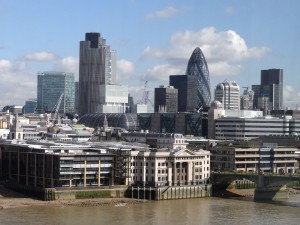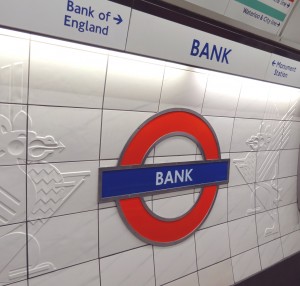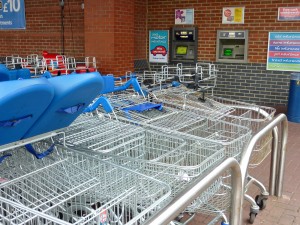 This has been a week of gloomy prognostications. On Wednesday 16 May, the Bank of England published its quarterly Inflation Report – and it makes worrying reading.
This has been a week of gloomy prognostications. On Wednesday 16 May, the Bank of England published its quarterly Inflation Report – and it makes worrying reading.
The forecast of UK economic growth for 2012 has been reduced from 1.2% in the previous report to 0.8%. But the rate of inflation is forecast to remain above the 2% target well into next year. However, at the two-year horizon, inflation is now forecast to be 1.6% – below the target, thus giving the MPC scope for further quantitative easing.
In the introduction to the report, the Governor, Mervyn King, writes:
Over the past year or so, two factors have hampered the recovery and rebalancing by more than expected. First, higher-than-expected world commodity and energy prices have squeezed real take-home pay, dampening consumption growth. Second, credit conditions, far from easing, have in some cases become tighter. The direct and indirect exposures of UK banks to the euro-area periphery have affected funding costs as the challenges of tackling the indebtedness and lack of competitiveness in those countries have intensified.
And at the news conference launching the report, he said:
We have been through a big global financial crisis, the biggest downturn in world output since the 1930s, the biggest banking crisis in this country’s history, the biggest fiscal deficit in our peace time history and our biggest trading partner – the euro area – is tearing itself apart without any obvious solution.
The idea that we could reasonably hope to sail serenely through this with growth close to the long run average and inflation at 2% strikes me as wholly unrealistic. We’re bound to be buffeted by this and affected by it.
 The following articles look at the Bank of England’s predictions and at the challenges facing the UK economy as the crisis in the eurozone deepens and as inflation in the UK remains stubbornly above target. They also look at the issue of the extent to which capacity has been lost as a result of the continuing weakness of the UK economy. As The Economist article states:
The following articles look at the Bank of England’s predictions and at the challenges facing the UK economy as the crisis in the eurozone deepens and as inflation in the UK remains stubbornly above target. They also look at the issue of the extent to which capacity has been lost as a result of the continuing weakness of the UK economy. As The Economist article states:
Business surveys suggest only a small proportion of firms are operating below capacity. That finding looks odd given the economy’s output is still 4% below its level at the start of 2008, and is much farther below the level it would have reached if GDP growth had continued at its long-term rate. The picture painted by surveys could be right if a chunk of the economy’s potential has been written off for good. But Sir Mervyn King, the bank’s governor, doubts this. There is “no obvious reason” why the economy could not rejoin its pre-crisis path, though it might take a decade or two to get there, he said on May 16th.
We look in more detail at the question of lost capacity in Part 2.
Articles
 Bank of England cuts growth forecasts: Sir Mervyn King’s speech in full The Telegraph (16/5/12)
Bank of England cuts growth forecasts: Sir Mervyn King’s speech in full The Telegraph (16/5/12)
Bank of England sees inflation up and growth falling Independent, Ben Chu (17/5/12)
Hard going The Economist (19/5/12)
Bank of England optimism dented again Financial Times, Chris Giles (16/5/12)
Eurozone is ‘tearing itself apart’, says Mervyn King. True, but the UK’s problems are as intractable as ever The Telegraph, Philip Aldrick (16/5/12)
Inflation Report
Inflation Report: portal page Bank of England
Inflation Report: May 2012 Bank of England (16/5/12)
Additional Data
Statistical annex to European Economy. Spring 2012 European Commission, Economic and Financial AffairsAnnual macro-economic database European Commission, Economic and Financial Affairs (11/5/12) (see particularly section 6.5)
Forecasts for the UK economy HM Treasury
Questions
- What explanations are given for the rate of CPI inflation remaining persistently above the 2% target?
- Why have the prospects for economic growth worsened since the publication of the February Inflation Report?
- How might it be possible to have a narrowing (negative) output gap and yet a stagnant economy?
- Why may capacity have been lost since the financial crisis of 2008?
- Why has M4 declined despite the programme of quantitative easing? (See M4 in record fall despite QE.)
- What scope is there for monetary policy in achieving faster economic growth without pushing inflation above the 2% target?
 The Bank of England was granted independence to set interest rates back in 1997. In setting rates its looks to meet the government’s annual inflation rate target of 2 per cent (with a range of tolerance of up to 1 percentage point).
The Bank of England was granted independence to set interest rates back in 1997. In setting rates its looks to meet the government’s annual inflation rate target of 2 per cent (with a range of tolerance of up to 1 percentage point).
The economic benefits of delegating interest rate decisions to a body like the Monetary Policy Committee (MPC) are often taken for granted. But, in David Blanchflower’s article in the Independent Newspaper on 14 May, the former MPC member questions whether, at least in recent years, better decisions would have been made by the Treasury and the Chancellor of the Exchequer. In other words, could politicians have made more appropriate monetary policy choices?
Central bank independence has become increasingly popular. Many governments have taken steps to depoliticise monetary policy choices and to hand over important powers, such as setting interest rates, to central bankers. One of the main advantages, it is argued, is that politicians are no longer able to manipulate monetary policy choices in order to try and affect their popularity and their chances of being re-elected. The policy announcements of central bankers are said to be more credible because they do not have the incentive to deviate from their announced policy. For instance, the low inflation announcements of elected policy-makers lack credibility because politicians have an incentive to inflate the economy and so boost growth and employment prior to the election.
The incentive for a pre-election dash for growth means that the general public are reluctant to bargain for low wage increases in case policy is loosened or is looser than it should be given the prevailing economic climate. In this case, it might mean that interest rates are lower than they would otherwise be in the run up to the election. In order to protect their spending power households bargain for higher wage increases than they would if the policy announcements could be trusted. In contrast, the low inflation announcements of central bankers have credibility and so inflation will be lower. In terms of economic jargon, central bank independence will reduce inflation bias as well as promoting economic stability.
Blanchflower questions whether the path of interest rates in the UK between 1997 and 2007 would have been materially different should the Treasury have been setting interest rates rather than the MPC. But, he believes that:
Interest rates would probably have been higher in 2007 as the housing boom was ranging and house price to earnings ratios approached unsustainable levels. Alistair Darling has made it clear he would have cut rates earlier in 2008, if it had been left to him….
Blanchflower argues that part of the reason that the Treasury might have made better choices in the more recent past is the narrow remit of the Bank of England to target inflation. He argues:
Now is the time to consider switching to a dual mandate that would include growth, which would give much needed flexibility.
Blanchflower calls into question the idea that targeting inflation alone can bring stability. The recent past he argues simply dispels this notion. To help form your own views try having a read of the full article and then answer the questions below.
David Blanchflower Article
The recession deniers have gone strangely quiet this month Independent, David Blanchflower (14/05/12)
Questions
- If economic growth is a good thing, why might we want to reduce the chances of policymakers manipulating policy to attempt a pre-election dash for growth?
- What do you understand by credible economic policy announcements? How might a lack of credibility affect the economy’s rate of inflation?
- What does central bank independence mean for the conduct of monetary policy in the UK? In answering this you might wish to visit the Bank of England website and read about the UK’s monetary policy framework.
- Try summarising David Blanchflower’s argument against the inflation rate remit of the Bank of England.
- What do you consider to be the possible dangers of widening the Bank of England’s remit beyond just targeting the annual rate of CPI inflation?
- Central bank independence is one way in which governments can constrain their discretion over economic policy. In what other ways can they constrain their policy choices?
- Do you think governments should have full discretion over their policy choices or do you think there should be limits?
 The UK is officially back in recession: or to be more accurate, a double-dip recession.
The UK is officially back in recession: or to be more accurate, a double-dip recession.
The generally accepted definition of a recession is two or more quarters of negative growth in real GDP. According to figures released by the Office for National Statistics, the UK economy shrank by 0.2% in quarter 1, 2012, having shrunk by 0.3% in quarter 4, 2011.
(Click on the following link for a PowerPoint of the above chart: Double dip 2)
As you can see from the chart (click chart for a larger version), these declines are tiny compared with the recession of 2008/9. Nevertheless, with the eurozone economy slowing (Britain’s largest export market), and with cuts to government expenditure set to bite harder in the coming months, there are worries that there may be more quarters of negative growth to come.
So what are the causes of this double-dip recession? Are they largely external, in terms of flagging export markets; or are they internal? Is the new recession the direct result of the tight fiscal policy pursued by the Coalition government?
And what is to be done? Is there no option but to continue with the present policy – the government’s line? Or should the austerity measures be reined in? After all, as we saw in the last blog post (Economic stimulus, ‘oui’; austerity, ‘non’), the mood in many European countries is turning against austerity.
The following articles explore the causes and policy implications of the latest piece of bad news on the UK economy.
Articles
Double-dip recession a terrible blow for George Osborne Guardian, Larry Elliott (25/4/12)
Double-dip recession figures mark another bad day for George Osborne Guardian, Larry Elliott (25/4/12)
UK double-dip recession: what the economists say Guardian (25/4/12)
Feared double dip recession becomes reality as British economy contracts again in first quarter of 2012 Daily Record (25/4/12)
Britain in double-dip recession as growth falls 0.2pc The Telegraph, Angela Monaghan and Szu Ping Chan (25/4/12)
Did the eurozone crisis cause the double-dip recession? Guardian, Polly Curtis (25/4/12)
UK’s double-dip recession Financial Times, Chris Giles (25/4/12)
UK is in ‘double dip’ recession FT Adviser, Rebecca Clancy and John Kenchington (25/4/12)
 Flanders explains GDP figure BBC News, Stephanie Flanders (25/4/12)
Flanders explains GDP figure BBC News, Stephanie Flanders (25/4/12)
No recovery for UK: No let up for ONS BBC News, Stephanie Flanders (25/4/12)
Double-dip recession: There’s always fantasy island BBC News, Paul Mason (25/4/12)
UK double-dip recession to drag on into summer, economists warn The Telegraph, Philip Aldrick (26/4/12)
George Osborne can stop the rot, but only by spending as he slashes The Telegraph, Jeremy Warner (25/4/12)
Double dip has arrived – and Osborne is running out of escape routes Independent, Ben Chu (26/4/12)
Britain’s bosses tell the ONS: it’s bad, but not a recession Independent, Tom Bawden, Lucy Tobin , Gideon Spanier (26/4/12)
The Chancellor received plenty of warning Independent, David Blanchflower (26/5/12)
Data
Gross Domestic Product: Preliminary Estimate, Q1 2012 ONS (25/4/12)
Preliminary Estimate of GDP Time Series Dataset 2012 Q ONS (25/4/12)
World Economic Outlook Database IMF (17/4/12)
Business and Consumer Surveys (for all individual EU countries and for the EU as a whole) European Commission: Economic and Financial Affairs
Consumer Confidence Nationwide Building Society
Questions
- Assess the current state of the UK economy and its likely course over the coming few months.
- Why may looking at the business surveys provide a truer picture of the state of the UK economy than the official measure of GDP?
- Why has the UK economy gone back into recession?
- Compare the policy approaches of the Coalition government with those of the Labour opposition.
- How important is it for the UK to retain its AAA credit rating?
 A crucial determinant of the economy’s short-term prospects is the appetite of households for spending. This is because household spending makes up roughly two-thirds of the total demand for firms’ goods and services or two-thirds of what economists refer to as aggregate demand. So what are the latest forecasts for consumer spending? We briefly consider the forecasts of the Office for Budget Responsibility for consumer spending and, in doing so, update an earlier bog Gloomy prospects for spending in 2012?
A crucial determinant of the economy’s short-term prospects is the appetite of households for spending. This is because household spending makes up roughly two-thirds of the total demand for firms’ goods and services or two-thirds of what economists refer to as aggregate demand. So what are the latest forecasts for consumer spending? We briefly consider the forecasts of the Office for Budget Responsibility for consumer spending and, in doing so, update an earlier bog Gloomy prospects for spending in 2012?
In its March 2012 Economic and Fiscal Outlook the Office for Budget Responsibility presents it forecasts for economic growth and household spending. The following table summarises these forecasts.
OBR Forecasts (annual real percentage change)
|
2012 |
2013 |
2014 |
2015 |
2016 |
| GDP |
0.8 |
2.0 |
2.7 |
3.0 |
3.0 |
| Consumption |
0.5 |
1.3 |
2.3 |
3.0 |
3.0 |
| Disposable income |
–0.2 |
0.5 |
1.9 |
2.4 |
2.5 |
 This has been a week of gloomy prognostications. On Wednesday 16 May, the Bank of England published its quarterly Inflation Report – and it makes worrying reading.
This has been a week of gloomy prognostications. On Wednesday 16 May, the Bank of England published its quarterly Inflation Report – and it makes worrying reading. The following articles look at the Bank of England’s predictions and at the challenges facing the UK economy as the crisis in the eurozone deepens and as inflation in the UK remains stubbornly above target. They also look at the issue of the extent to which capacity has been lost as a result of the continuing weakness of the UK economy. As The Economist article states:
The following articles look at the Bank of England’s predictions and at the challenges facing the UK economy as the crisis in the eurozone deepens and as inflation in the UK remains stubbornly above target. They also look at the issue of the extent to which capacity has been lost as a result of the continuing weakness of the UK economy. As The Economist article states: Bank of England cuts growth forecasts: Sir Mervyn King’s speech in full The Telegraph (16/5/12)
Bank of England cuts growth forecasts: Sir Mervyn King’s speech in full The Telegraph (16/5/12)


